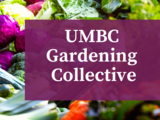Embarking on a Journey to At-Home Composting
Get started reducing your waste and nourishing your garden!
A guest post by Kayla Hickman, UMBC’s Environmental Sustainability Coordinator
My ecological footprint is one I think of often. The earth is a finite planet with many inhabitants who all depend on it for survival. To be honest, the size of my ecological footprint used to keep me up at night with eco-anxiety. In order to be resilient working in the field of sustainability, I choose to focus on things that are in my control. That is the reason why I love talking about trash so much.
Yes, you heard right, trash.
I started my ‘zero-waste’ journey about 3 years ago. I use air quotes because I still create plenty of waste, but I celebrate my many waste reduction victories.
The global pandemic has reduced our collective ecological footprint in many ways. Our carbon emissions are down because we don’t drive as often. However, that being said I have definitely increased my use of plastics. In these times it is important that we prioritize the health of ourselves, family, and community. Sometimes that means buying items like gloves, masks, disinfectant wipes, and hand sanitizers that are made up of plastic.
In this wave of new waste, I was starting to feel a little hopeless. Reducing my waste had become such an empowering experience and I felt like I was backtracking. I had to ground myself again, focusing on what I can do at this moment. The global pandemic was the push I needed to start doing something I only ever talked about: at-home composting.
Composting at home can seem like a scary and daunting process. I am here to tell you that it isn’t as scary as you think! Regardless if you live in an apartment or 1-acre plot of land there is a composting option for you. I live in a 900 sqft apartment with very limited outdoor space, so I decided that Vermicomposting was the best option for my household. It has been such a rewarding experience. In a world full of uncertainty, composting has given me a sense of self-reliance that I needed. It has also given my small quarantine garden the nutrients to thrive.
So if you are looking to reduce your waste, feel empowered, or have a cool science experiment for the family, composting may be for you!
Choosing an At-Home Composting Option
There are many different composting options you can pursue. The factors to consider include:
- Living space and access to personal outdoor space
- The type of organics you will be composting
Below is a graphic created by Earth Easy to help guide you to the best option for your household:
Basics of Composting:
No matter how you compost there are general rules of thumb that are important to follow to make sure you have a healthy compost pile:
- Items to place in your compost bins:
- Here is a quick graphic on what you should and should not place in your compost
- Greens to Browns ratio:
- In the above graphic, organics are separated into two categories: greens and browns. This is common terminology used to distinguish between organic waste that is wet and high in nitrogen (greens) and dry and high in carbon (browns).
- In general, blend equal parts of browns and greens by either volume or weight every time you feed your pile
- Troubleshooting your compost:
- Composting is a learning process, just like starting your own garden. There are compost troubleshooting guides to help navigate these issues:
Resources to Get Started
There are a ton of different resources available on composting, which is kind of overwhelming. These are resources that I found helpful when I started composting!
- General Composting Resources:
- NPR’s Life Kit: How to Compost At Home
- UMD Extension: Composting 101
- Baltimore County: DYI Compost Bin Instructions
- NYC: Outdoor Composting Guide
- Vermicomposting Resources:
- EPA Guidance on how to build and maintain a worm bin
- Food Print’s Vermicomposting 101 (contains great tips to maintaining healthy worms)
- NYC: Vermicomposting Guide
We are in this composting journey together! With that being said, feel free to contact me with any questions or to share your composting stories/best practices at khickman@umbc.edu.
Sustainably yours,
Kayla
Tags:
Posted: August 3, 2020, 8:33 AM
